Beijing Subway Openings 2024 Part 1
Beijing Subway now has become the world's largest metro system by length AND number of stations, with the opening of two new fully automated metro lines.
In late December 2024, I hopped on a high speed train up to Beijing from Hong Kong. The reason? Some family from North America also happened to be in Beijing around this time for work. So why not go visit them and see some new metro lines at the same time. I can assure you, the former is the bigger motivator. I swear on a ex-KCR SP1900 series front coupler faring.
Beijing had some huge openings in December 2024 with the opening of the 14.7km 10 station, Line 3 Phase I; the monster 27.5km, 20 station Line 12 Central Section from Sijiqingqiao to Dongbabei; and lastly a small southern extension of Changping Line down to Jimenqiao. These extensions added about 45km to the Beijing Subway, bringing its length to 879 km (546 mi), cementing the Beijing Subway as the longest metro system in the world. In addition, these new extensions bring the Beijing Subway network up to 424 unique stations, surpassing the New York Subway, as the metro system with the most stations in the world. In this multi part series, I will cover my transit experience and thoughts on Beijing’s new rail openings in December 2024. With this Part 1 article covering my experience and thoughts with Line 12.
Getting to the Northern Capital’s New Northern Crosstown Metro Line
After a long high speed railway ride from Hong Kong, I arrived in Beijing West Railway Station a few days after the aforementioned lines opened:
I have to get from Beijing West Railway station to the Beijing 798 Art Zone where my relative was working. Luckily, the art district is now serviced by a newly opened, few day old, Line 12 station called Gaojiayuan Station! The wild thing was if I arrived one week earlier it would be very difficult to get to that art district because apart from the newly opened Gaojiayuan Station, there was no nearby active Beijing Subway station before the opening of Line 12. Being that I was at Beijing West Railway Station, I need to take the subway north then east across Beijing to the Beijing 798 Art Zone. Which means opportunity for extensive use of Line 12.
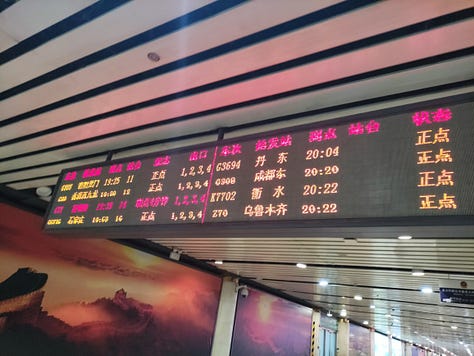
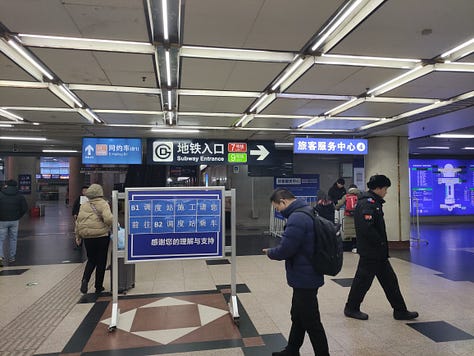
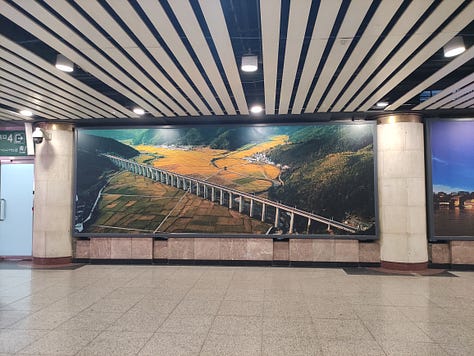
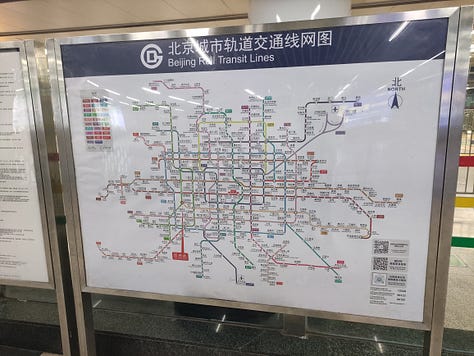
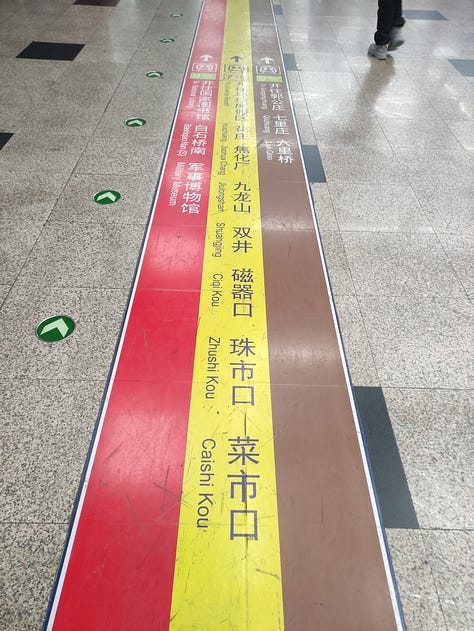

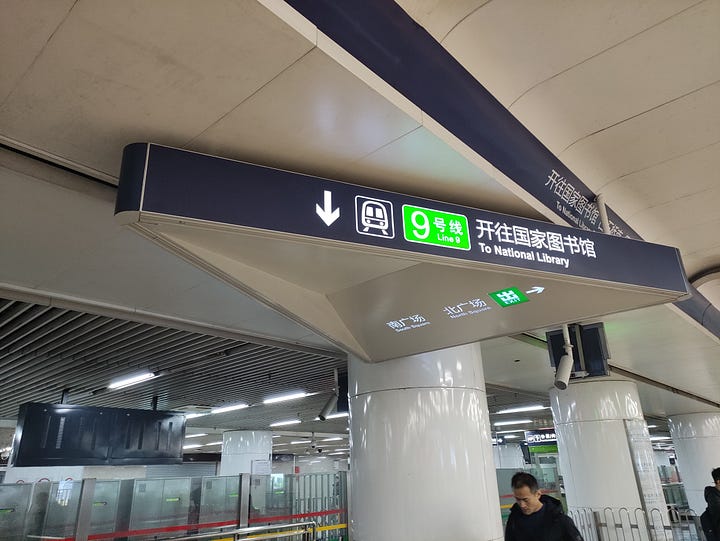
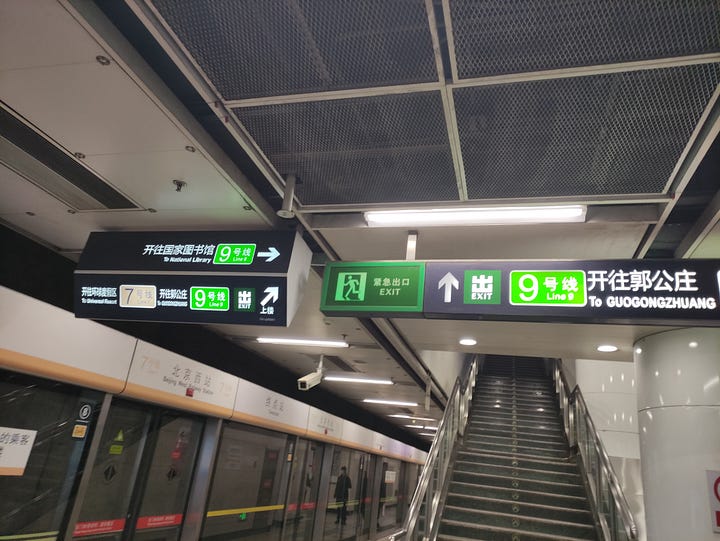
From the railway station, I take Line 9 north National Library Station to then transfer to Line 16. National Library Station has an excellent same direction cross platform interchange between Line 9 and Line 4:
I could have taken advantage of this cross platform interchange to change a Line 4 northbound train and continue my journey north to Line 12 but I wanted to ride Line 16. Line 16 is one of Beijing’s newer generation of lines built with massive capacity in mind. Planning failures with older Beijing Subway lines such as Lines 4, 5, 10 and 13 led to severe overcrowding on their smaller 6 car Type B trains. Line 5 is notoriously congested in the north:
Like Line 5 above, there is also this really old viral video of Xi’erqi Station being packed during AM rush on Line 13.
Newer generations of lines, such as Line 3, 12, 14, 16, 17, 18, 19 and 20 are planned and built to support large high capacity 6 to 8 car Type A trains, which have a 30% to 60% increase in capacity respectively compared to Beijing’s older 6 car Type B lines. Some of these lines, like Line 3 and Line 12 being reviewed here, were also envisioned to be somewhat of an express relief counterpart to Beijing’s existing congested lines. These lines have top service speeds of 100-120 kph and wider stop spacings of 2-4 km. Line 5 in the above tweet will hopefully be relieved by a completed Line 17. Line 13 shown in the above video has already been relieved by Line 19. Today, Xi’erqi Station is crowded but not insanely crowded like the video.
Below is Beijing Subway Line 16, one of those aforementioned new generation of high capacity lines that I was briefly experiencing on my way to Line 12:
Line 16 is working in tandem with Line 19 to be the relief line for Line 4. Line 4 and 16 are even operated by the Hong Kong MTR, so even though I just got off an 8 hour bullet train ride from Hong Kong, the announcements, vibes and wayfinding sort of made me feel like I didn’t leave home:
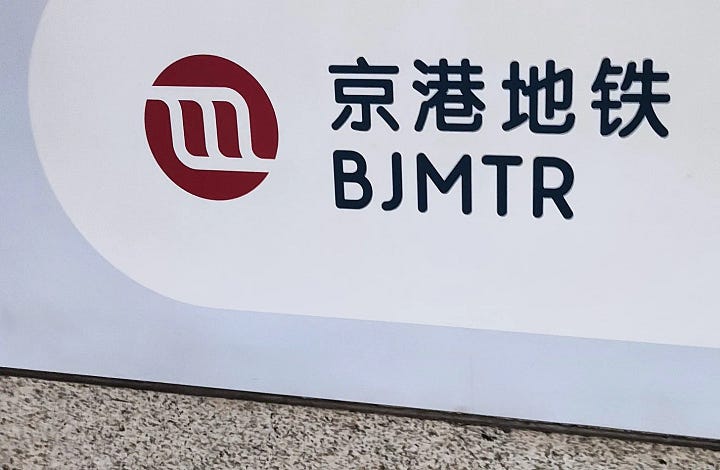

After enjoying Line 16, I finally arrive to Suzhouqiao Station to interchange with Line 12, with its LCD passenger information displays:
Going down to the few day old platforms of Line 12 at Suzhouqiao Station:

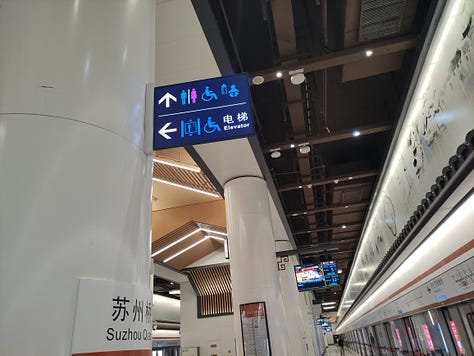
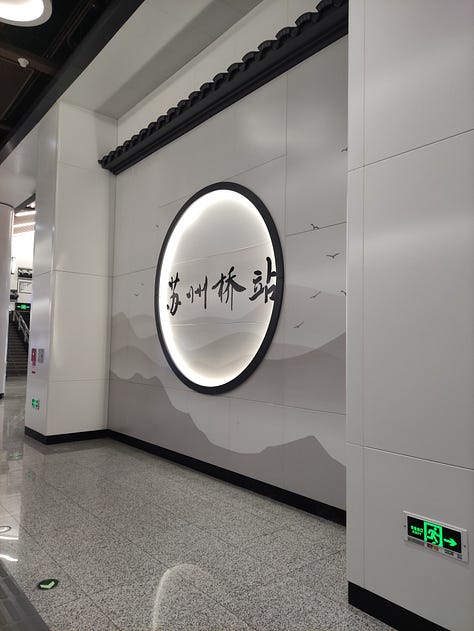
The Fully Automated Luxury Space Metro Paradigm
Line 12 uses 4 car Type A trains but all platforms are designed and fully built out to support trains in 4, 4+4 and 8 car configurations. This design is a new approach the Beijing Subway is experimenting with after the completion of the first new generation of high capacity lines such as Lines 16, 17 and 19. Due to this new design the platforms have a lot of temporary wayfinding and retractable belt barriers scattered around to mark the unused parts of the platform but still allow access to the full suite of station services like escalators, elevators and platform level bathrooms etc.
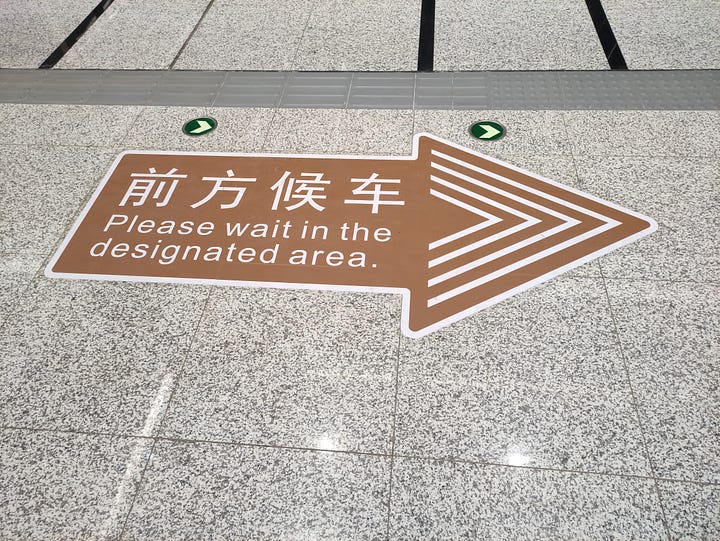

The rational for this new design philosophy in the 2nd generation of high capacity lines is to allow for the operation of mixed half and full consists, reflected in later lines such as Lines 3, 12 and 20 (4+4 car Type A) or Lines 11 and M101 (3+3 car Type A). The currently operating Line 19 Phase 1 (which uses full 8 car Type A trains today) is planned to be retrofitted to similarly to support 4+4 car Type A operations to align with the other new lines like Line 3 and 12. As spelled out in Line 19 Phase 2 North and South extension EIA noted in my tweet below:
Traditionally metro operators had fixed train consists (though exceptions exist) and would adjust capacity with demand throughout the day by running more and less frequent service. As the capacity of a train car and number of train cars in a train remain fixed. As the capacity of a metro or train line is defined by:
Frequency of service every hour × capacity of a train car × number of train cars in a train
If we take this Beijing Subway Line 9 schedule below as an example:
From the schedule above, you can see how operators change frequency to match capacity with how demand changes throughout the day. Line 9 uses 6 car Type B trains that, like many metro trains of the world, do not change in length. Between 7 to 9AM (AM rush) Line 9 operates 24 trains per hour (every 2 minutes 30 seconds) but 9 trains per hour (every 6 minutes 40 seconds) during the middle of the workday. This yields the following capacities throughout the day:
AM Peak period capacity in people per hour per direction (pphpd):
24 trains per hour × 230 people per type B traincar × 6 cars per train = 33,120
Midday period capacity in people per hour per direction (pphpd):
9 trains per hour × 230 people per type B traincar × 6 cars per train = 12,420
Some transit operators back in the day, particularly in the US which fully embraced married pair EMUs, would constantly be breaking up and adjusting train married pair units into consists in multiples of two to match whatever lower off peak demand. With the theory going that during all off peak hours half the train would always be empty, so running empty cars around would unnecessarily wear out your fleet and increase your maintenance costs. Everyone can just make do with a shorter off peak train and have a few standees off peak.
Transit activists love to obsess over the labor costs of drivers on trains. This cost is often overstated and might actually be a minority in the total labor costs of running a railway. However, having a large portion of your fleet run around empty all day does increase your maintenance turnover and by extension manhours for some very expensive and specialized labor. Not to mention the additional electric bill from moving around and just air-conditioning a bunch of empty cars all mid-day everyday.
Regardless, as great as playing around with train consists sound, over time many operators abandoned this practice as yard crew labor and fleet organization costs may have outpaced the estimated savings in reduced rolling stock maintenance parts and manhours. Perhaps, rolling stock maintenance and fleet dispatching has seen productivity gains in the last few decades, reducing the delta on potential savings. While coupling and uncoupling trains still remains a very tedious and labor intensive process. As shown below with this JR-W Hanwa Line Rapid train I was on which runs in 4+4 car sets but splits into two trains that head to different branches: the Kansai Airport branch and continuing down the Hanwa Line to Wakayama:
As such, using traditional methods of combining and separating trains does not scale for massive urban(e) railway systems, like you see in China, let alone the world’s largest subway system in Beijing. Imagine how a massive, busy system in China with a fleet of railcars numbering in the tens of thousands, needing thousands of trains to be manually broken up after AM rush, recombined for PM rush then broken up again for evening service. All throughout the day, every day.
However, today we live in an age of Fully Automated Luxury Space Metro Communism. If trains are fully automated and could automagically™ couple and uncouple, a vision the Beijing Subway is seemingly attempting to design for, two things are now possible:
The labor costs of operating each train is reduced with automation, meaning a minimization in marginal cost for every increase in provided service (trains can run frequently at lower cost) and;
With automated coupling and uncoupling, capacity throughout the day can easily be scaled up and down not only by frequency but also by the capacity of each individual train. The automated nature removes the labor intensiveness of the almost constant process of changing train lengths.
The vision for Beijing’s “half consist capable” lines is by using automatic coupling and uncoupling, capacity deployment will be less tied to headways. The hope is trains could be coupled and uncoupled while in service at a terminal station without going back to the depot. This will avoid the large maintenance and electricity costs of just simply running lots of automated massive trains designed for East Asian peak periods frequently (every 2-3min) during the off-peak period. As during the off-peak there will be no demand for over 40,000 people per hour per direction of capacity and the trains will be largely empty, potentially causing optics problems with the public. The goal, ultimately, is reducing labor costs and shift complexity of changing the size of trains every day, combined with the already low labor cost of running fully automated trains to achieve high all day frequency for the passenger. The passenger can not feel how long a train is (unless its crowded all the time, then they start asking questions eg Guangzhou) but passengers do feel how frequently it comes. Beijing Subway is attempting to provide frequent service all day from AM peak period to midday to PM peak period to late evening while still having massive +50,000 people per hour per direction capacity available on tap as needed.
An example of how this would play out in the Beijing Subway would be for say, Line 3, heavy rush hour demand requires a 8 car train running every 2 mins, so light metros are out of the question. (unless you are Guangzhou, then… ) However, you can run a large 4+4 car set every ~2 mins to satisfy your peak hour capacity requirements. At the same time during the midday Line 3 can automatically, with minimal supervision, uncouple a bunch of their 4+4 car trains and run the 4 car sets every 3 mins. In a traditional fixed trainset model, Line 3 would be forced to run a full 8 car set every 6 mins to get the same off-peak capacity but fleet utilization is higher and off peak waiting times are longer. By running these “half consist capable” lines Beijing Subway hopes to reduce midday waiting times while keeping a lid on maintenance and labor costs. Costs which are usually the constraints for providing a good metro service. As I described in a x/twitter post below:
If we go to the more concrete Beijing Subway Line 9 example earlier. If this concept of “half consist capable” lines is carried out, Line 9 would have a fleet of 3 car Type B trains that will link up to form full 6 car trains as a 3+3 car set during rush hours. In theory, with full automation and ability to automatically adjust train lengths, the following could be the service provided:
AM Peak period capacity using 3+3 car trains in people per hour per direction (pphpd):
24 trains per hour × 230 people per type B traincar × 6 cars per train = 33,120
Midday period capacity using 3 car trains in people per hour per direction (pphpd):
18 trains per hour × 230 people per type B traincar × 3 cars per train = 12,420
Note that the provided capacity here is exactly the same as what Line 9 currently runs that I noted above. But the ability to break out into 3 car trains during the midday off peak allows off peak service, providing the same capacity, to run every 3 minutes 20 seconds instead of every 6 minutes 40 seconds. Essentially if Line 9 followed Beijing's fully automated dynamically changing train concept, Line 9 will have trains running at least every 3 mins 20 secs all day every day. Imagine what this will do to people’s perception of off peak subway services. If more mature and intensively used lines in Beijing like Line 1 adopted this model, Line 1 would see train headways of 3 mins at worse, all day every day. This is with current demand, imagine the latent demand this will unlock from a mode shift away from electric scooters. (the bane of my existence)
You can also see how automated non-yard based coupling and uncoupling is important here, by how often you need to couple an uncouple your fleet of trains in one day.
Line 12 a Fully Automated Luxury Space Metro in Practice
Back to Line 12, the operation of 4 car half sets make it very strange to see because so little of the station platform is currently being used. Also note the individual LCD screens over each door that shows door status (door closing, which individual door to use for a 4 or 8 car train etc) and train crowding. A new standard feature for Chinese metros. Now deployed in some lines in the Shenzhen, Guangzhou, Taiyuan and Shaoxing Metros to name a few.
Line 12 right out the gate utilizes two types of rolling stock, ZBM05 series (left) by Beijing Subway Rolling Stock Equipment (some hipster small rolling stock plant related to the Beijing Subway) and CCD5049 series (right) by CRRC Changchun.
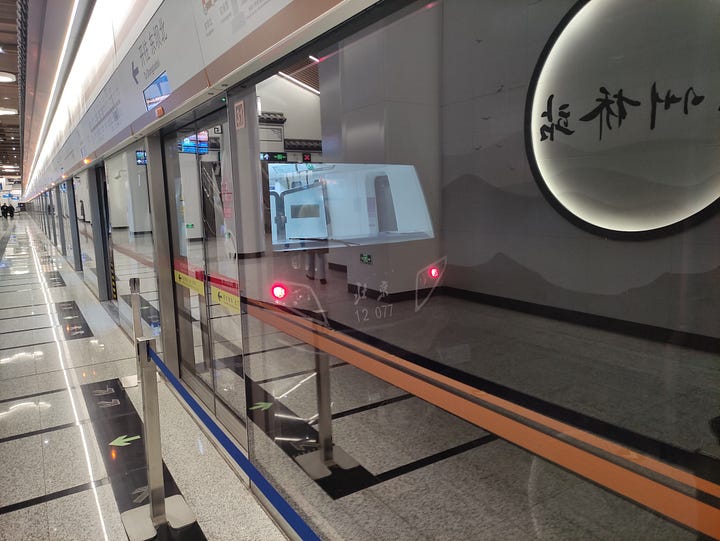
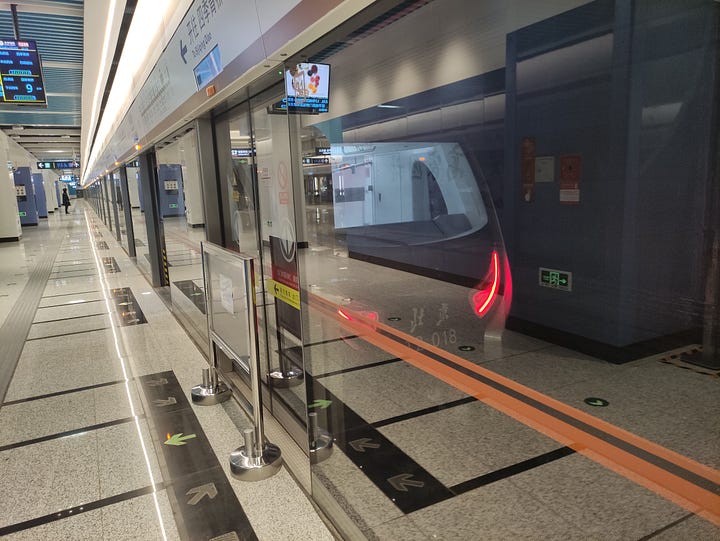
I observe from the pictures above, if the 4+4 consist model is to be followed, a standard Type A cab cars can not be used. According to China’s metro design standards GB 50157-2013 “Code for Design of Metro” (地铁设计规范)1
The standard notes that cab cars of all Chinese metro trains are over 1 meter longer than intermediate cars as presented by Table 4.1.5 below, compare 无司机室车辆 (“no cab car” or intermediate cars) with 单司机室车辆 (“single cab car”).
So if a 3+3 or 4+4 car configuration was used, the spacing between doors in the platforms screen door design has to be wider than normal at the halfway point of a full trainset. Guangzhou Metro Line 3 and Shanghai Metro Line 16 are good examples. As shown below with Guangzhou Metro Line 3 the door spacing between cars 4 and 3 of a 3+3 consist as shown below.
On Shanghai Metro Line 16 trains the gap where two units are coupled is even more pronounced as they are the larger Type A trains:

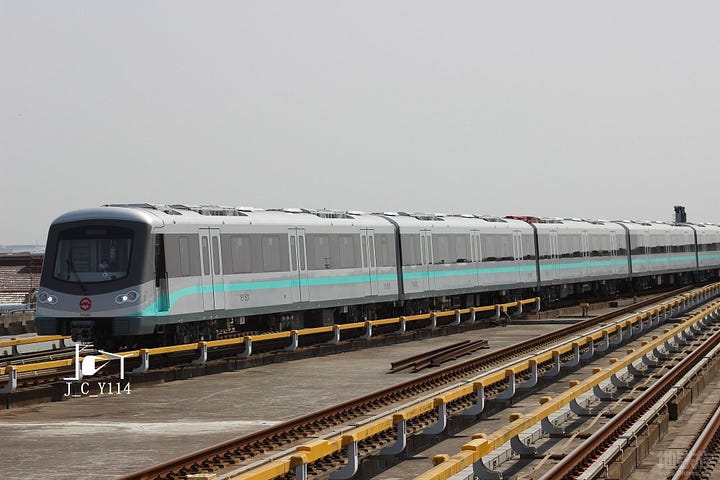
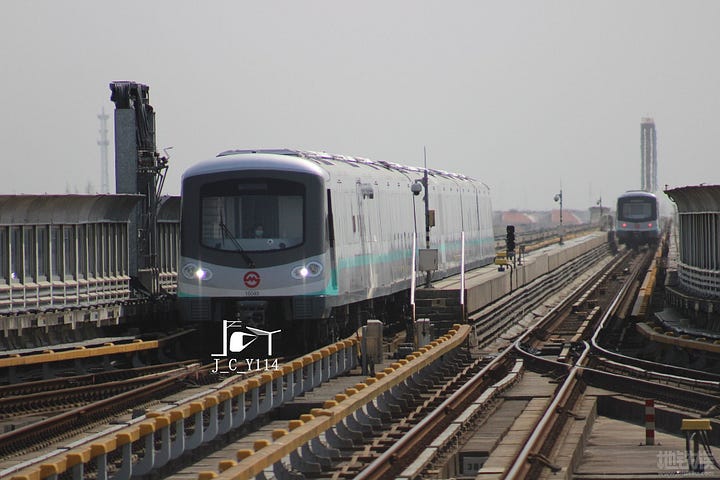
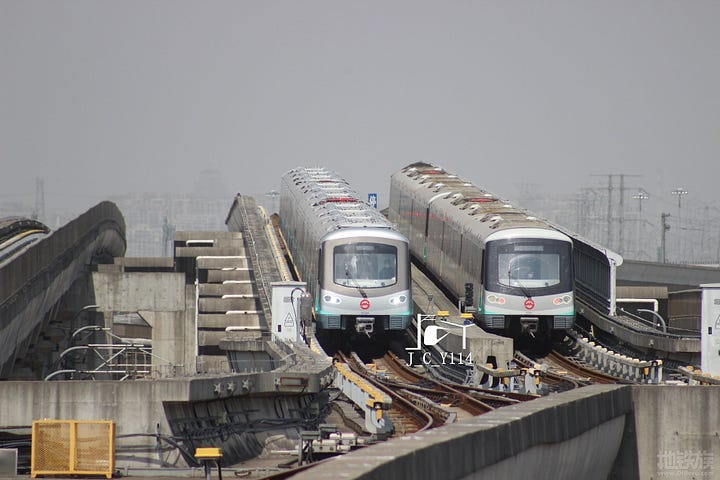
However, I did not observe this to be the case with Beijing Subway Lines 3 and 12. Today's 4 car trains on these lines have cabs that overhang into where the next car (car 5) would hypothetically sit. Unlike the Guangzhou Metro Line 3 and Shanghai Metro Line 16 examples above, you can see below that there is no extra gap in the platform screen door spacings between where cars 4 and 5 would be. You can see how the cab of a 4 car train spills over into the spot where the first door of a hypothetical car 5 in a 8 car consist would be for both Lines 3 and and 12 below (that cross platform interchange 🔥🔥🔥) :
You can also see above that the door spacings in the Platform Screen Doors (PSD) between each car remains consistent. Unlike the slightly longer gap in the half way point of a full train you would see in Guangzhou or Shanghai. With this information I suspect that the fleet expansion plan might be the existing 4 car trains running today will be expanded into fixed 8 car trains in the future with new inserted intermediate cars. On top of this, a subfleet of new 4 car trains that can auto couple will be procured. These new 4 car trains will have shorter stub nosed cab cars with the same dimensions as an intermediate car and a 4+4 car set would match the door spacings of a normal 8 car train. Which I guess works, in the automated train era a longer car to accommodate a “cab” that the passenger can not access is no longer needed. Of course what I just wrote is all conjecture but it does make sense to delay the manufacturing of the auto coupling 4 car trains as they are still fleshing out the signal system designs. This would avoid the need to retrofit the existing fleet which just become regular fixed 8 car trains that are only rolled out during peak periods when demand warrants more capacity.
I head on Line 12 to eat dinner at one of the largest malls in the world, the Golden Resources Shopping Center, with all its 6 million square feet (560,000 square meters) of gross leasable glory. Phase 1 of the mall is almost 600 meters long, 100 meters wide and has 7 floors. When the Golden Resources Shopping Center was completed in the early 2000s the mall was in the outskirts of Beijing, hard for anyone to get to (no Beijing subway access) and was largely empty. Today it is served by Line 10 and now (for a few days) Line 12, which I arrived on:
I enter the mall via the connecting Line 12 subway station (Landianchang):
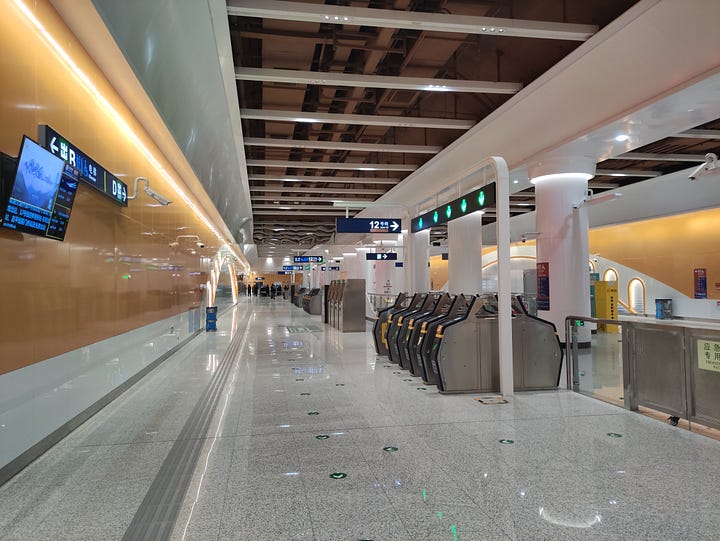
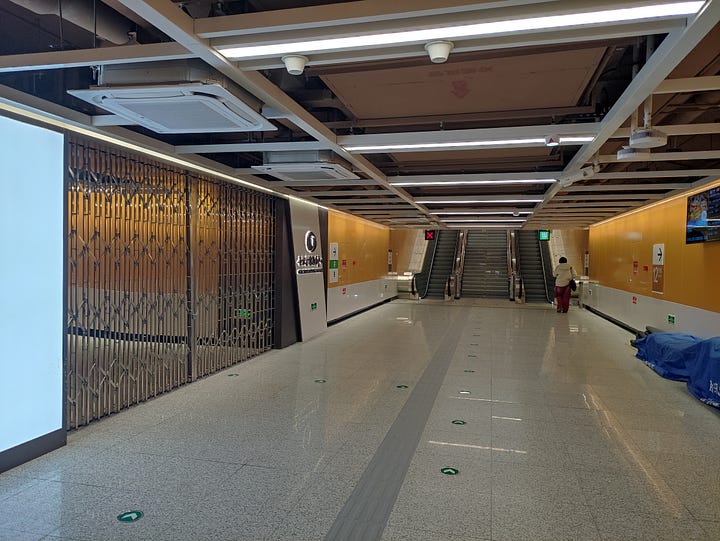
Golden Resources Shopping Center today it is filled up with stores and I was told it’s really busy on weekends. However, right now everything is soon closing for the day (its 10PM on a Thursday). So I rush around to see what I want to eat on the 6th floor which is packed with restaurants.
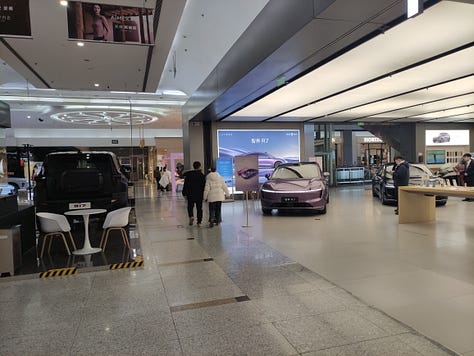

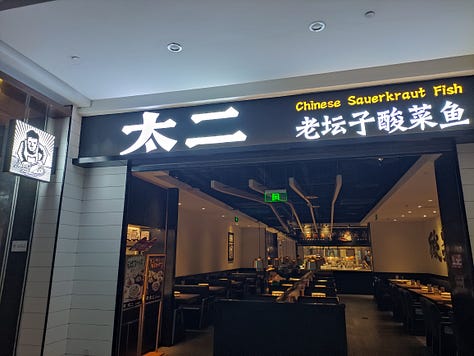


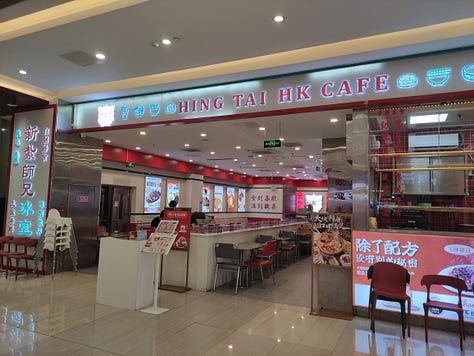


I was tempted by the Hong Kong Cha Chaan Teng but I remembered I did not travel all the way to Beijing to eat Hong Kong food. Also all the siumei hanging on the window was gone, not a good sign. So what I did was snag a big bowl of zhajiangmian before closing:
After my filling late dinner, I then head to Beijing 798 Art Zone which is at Gaojiayuan Line 12 station, where my relative is working and staying, from Changchunqiao Station. Which means a long slog across northern Beijing on one of the last trains of Line 12. I enter Changchunqiao Station the other adjacent Line 12 station that connects with the Golden Resources Shopping Center (it is that big):
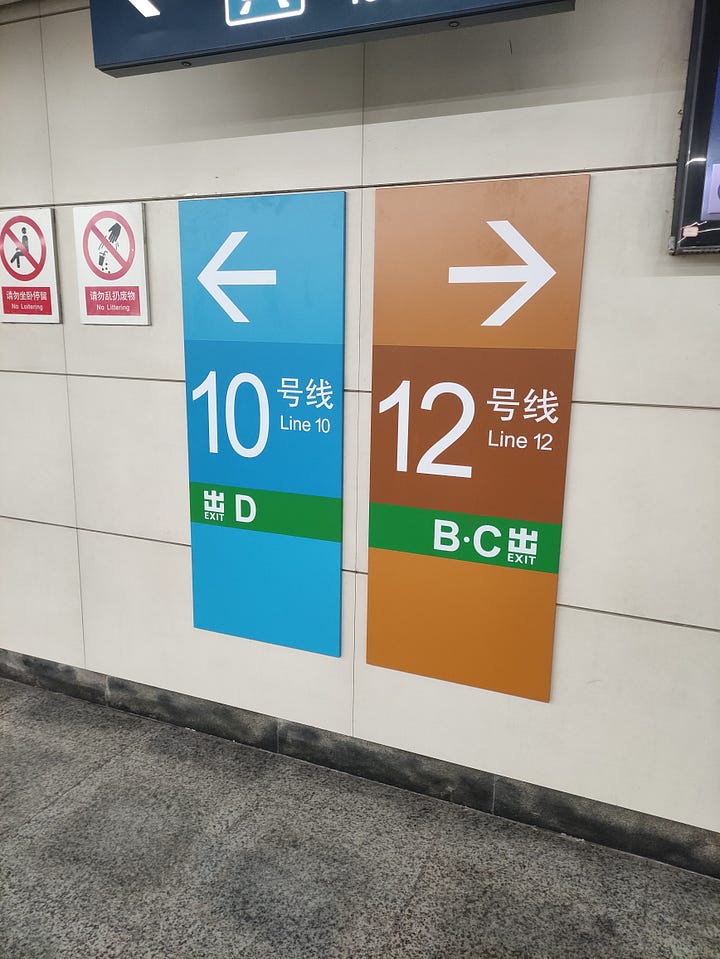
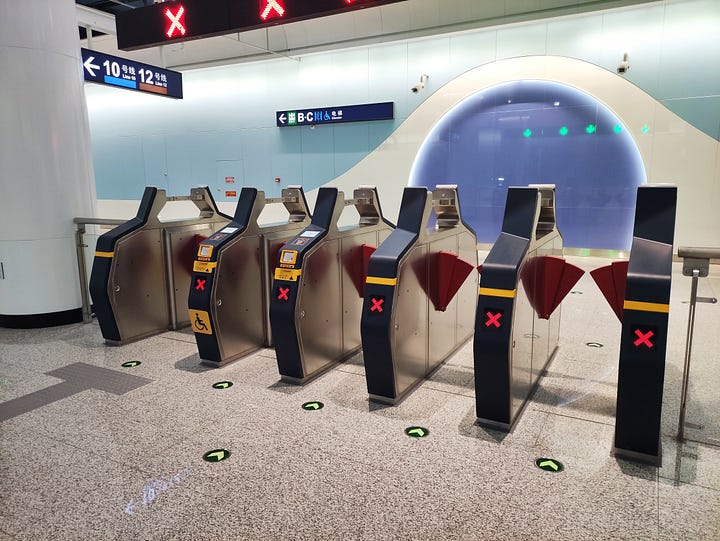
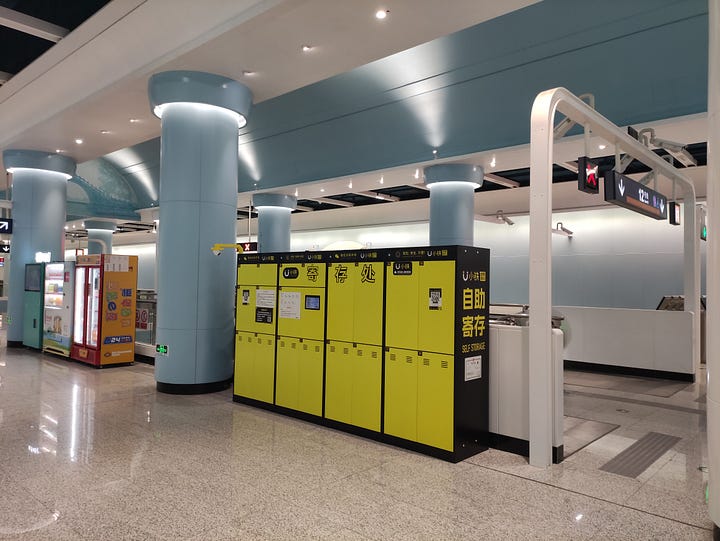
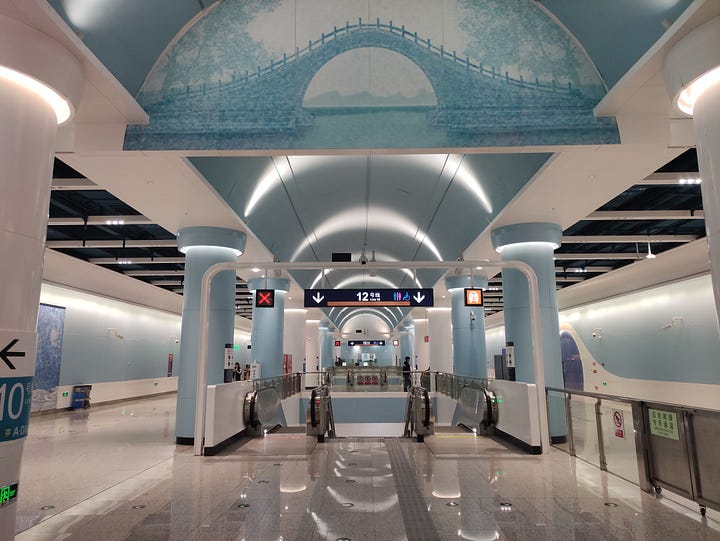
And take a late 11PM Line 12 train across Beijing to the Beijing 798 Art Zone.


As noted above another one of the common theme with Beijing’s newer high capacity metro lines are the fully automated trains. However, so far today they operate with an attendant on board and a semi permanent barrier was put between passenger and driver areas. Everyone has to peek over the (eye level height for me) barrier behind the driver to see the front. This is pretty typical of China to soft break-in a newly automated metro line with attendants to ensure everything is in order right after opening.
I arrive at Gaojiayuan Station, which is a nice little Line 12 station but was supposed to be an interchange station with Line 14.
However when Line 14 was suddenly redesigned from a 7 car Type B line to a 6 car Type A line (+9% capacity uplift) a lot of Line 14 stations had to be adjusted to the larger capacity. The Gaojiayuan Station Line 14 platforms to this day had land acquisition issues for the additional equipment room structures and remains inoperable. Even when Line 14 (and now Line 12 this year) has opened over 10 years ago.

A little bit north of Line 14, there is also supposed to be an interchange connection with the Beijing Capital Airport Express Line but that project has also seen minimal movement. An EIA for the infill station on the Beijing Capital Airport Express Line connecting to Line 14 was published in November 2024, a month earlier. Below on the left is where the new elevated infill Beijing Airport Capital Express station should be:
Back to the Gaojiayuan Line 12 station side you can see reserved connections all over the station with very clear blank Line 14 (pink) wayfinding. Hopefully they now have figured out how to use some of Line 12’s real estate to make Line 14’s Gaojiayuan platforms work.
Reunion!
After a short walk I arrive at the hotel my relative was staying at and I finally have a chance to sit down for a late night hotel reunion tea chat with them at the Beijing 798 Art Zone. What’s funny is when they noted to me a bit of a culture shock moment when they were in Beijing a few days ago. Initially because there was no subway access to Beijing 798 Art Zone (where they also stayed) they always called a Didi or taxi to get around Beijing and thought nothing of it. Unaware that a subway station near them will soon open. Then as my relative has (roughly) described it during our late night tea chat, knowing I am the “transit guy”:
“OMG one morning, a few days ago, some of the team we are working with told me they took the subway to work. Which I thought was strange being there is no subway here [798 Art Zone]. They told me a new subway station opened outside the complex. Wow, I arrive to Beijing for a few days and a new subway station opens near me, when has that ever happened back in Canada.”
I reminded them that things has happened on the transit front in Canada. This reflects my view on how “normies” view transit. Regular people only get exposed to a project when something really good or really bad happens to them personally or they hear about it in the news/from a friend. With today’s news cycle and gossip, usually it’s something bad. A metro line on the other side of town can open and a “normie” would not know or even care. From their perspective life is more than just getting to your destination in a city. (which is fair)
Urbanists and railfans may constantly obsess over and anticipate anything that happens to a transit project down to the dates. The average Joe, is usually very vaguely aware of the projects happening that may affect their lives by seeing the construction around them and occasionally talking about it with friends. From their perspective, the experience of sudden discovery of a transit project opening where they very concretely can envision (and experience) how their quality of life just improved can have a serendipitous, but most importantly positive, feeling of progress (at least on the public transport front).
Imagine this happening personally to everyone in a city collectively every few years. No vague promise of a project’s realization, no projects that never seem to ever get finished, no ads saying “It’s happening” for 10 years when nothing happened or a situation when (once in a blue moon) an expansion happens… but it is not in a part of the city they ever imagine needing to go. By the way, the last one was the retort my relative gave me when I listed the most recent transit expansion in their city: “That project happened a long time ago and is waste [useless] anyways.”
If projects are constantly opening, statistically a resident minding their own business and not really paying attention to local transport developments; will get to experience a sudden material improvement on how they get around their city a few times over a decade as they go on in life. Even all the technical stuff I noted in this post about automated coupling and high capacity Type A designs; regular people will not notice or even care. However, regular people do experience the effects of these features in the high off peak frequencies, high reliability, greater convenience and reduced crowding when using the system. This is how cynicism on transit is removed, social trust in the transport planning process is cultivated and the system’s “vibes” are developed.
So thanks for reading Part 1 on my experience with the new metro lines for Beijing. Stay tuned for Part 2:
Like, share and subscribe for more news on how the world’s largest subway system is getting larger.
Or support me on Ko-fi if you like what you read!
Yes it admittedly is out of date but still valid on this use case, it’s not like the trains suddenly changed sizes.




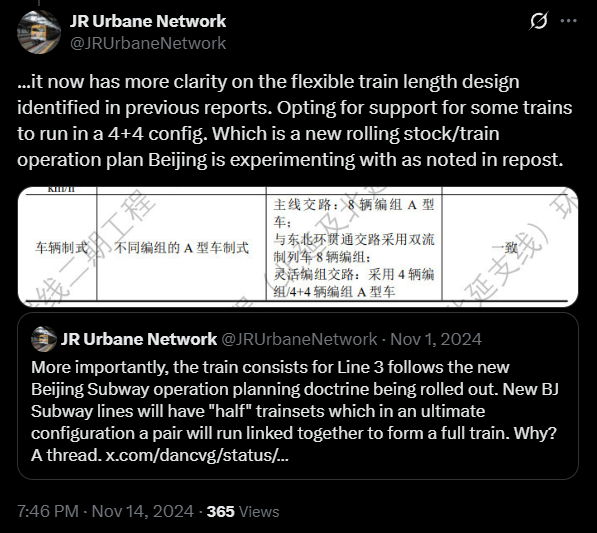


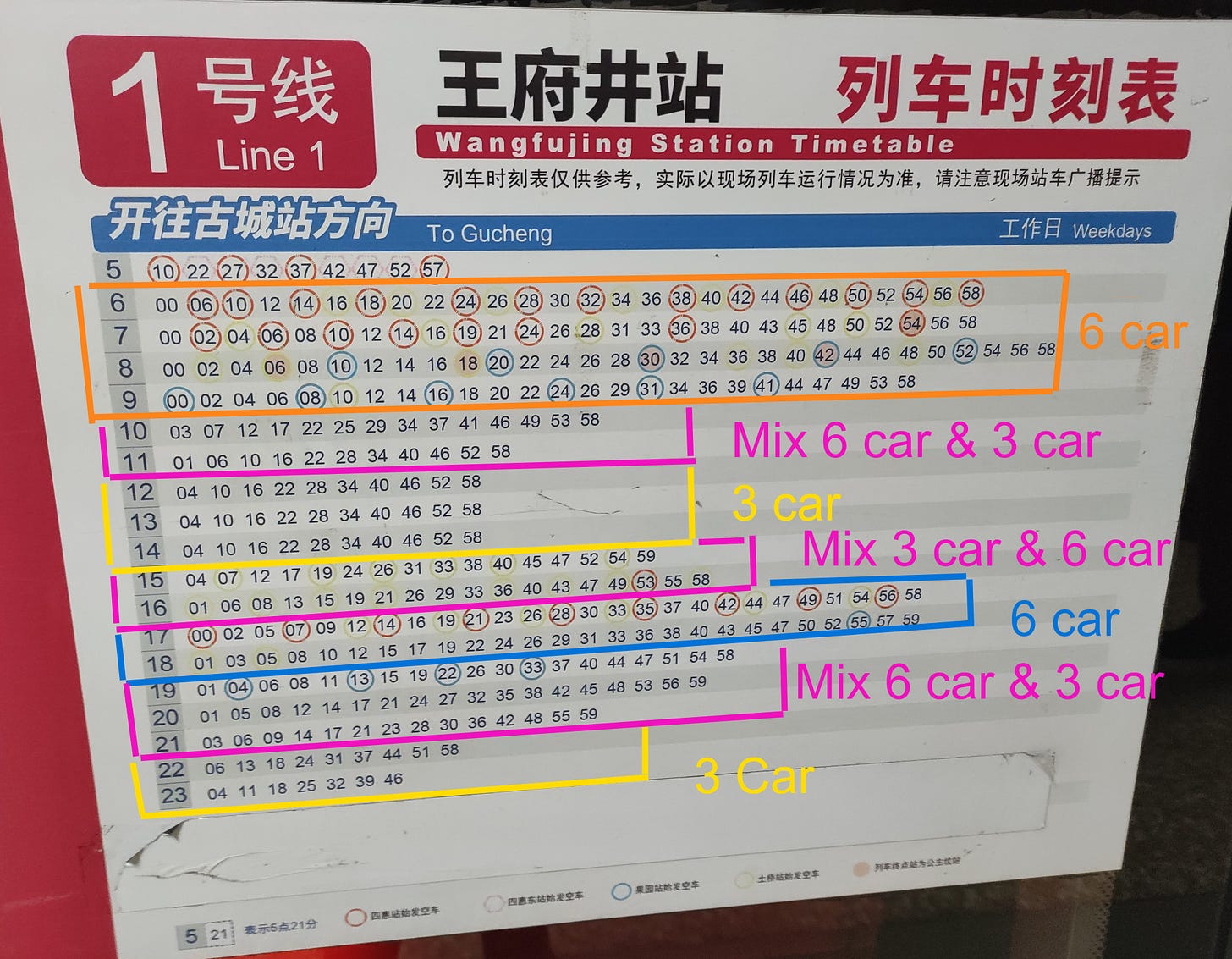






Absolutely fantastic read!
Great article and very impressive what they've achieved in Beijing!
Speaking of user friendliness, especially for normies: One thing that annoys me to no end with all Chinese subway systems are the constant security and bag checks. First, no other world city has those (including Hong Kong) so I don't understand what Chinese metro systems seem to know that literally no other metro system knows. And second, even if I was concerned for my safety on the metro (which I am not), those checks are so comically theater-like. No one ever asks to remove metal objects. Sometimes they ask to take a sip from a water bottle, sometimes they don't.
At least speaking for me, their whole "we are world leaders in operating metros" branding falls apart the moment I am once again exposed to this ridiculous security theater that seems to serve no purpose except for providing employment to 100,000s of people across the country.